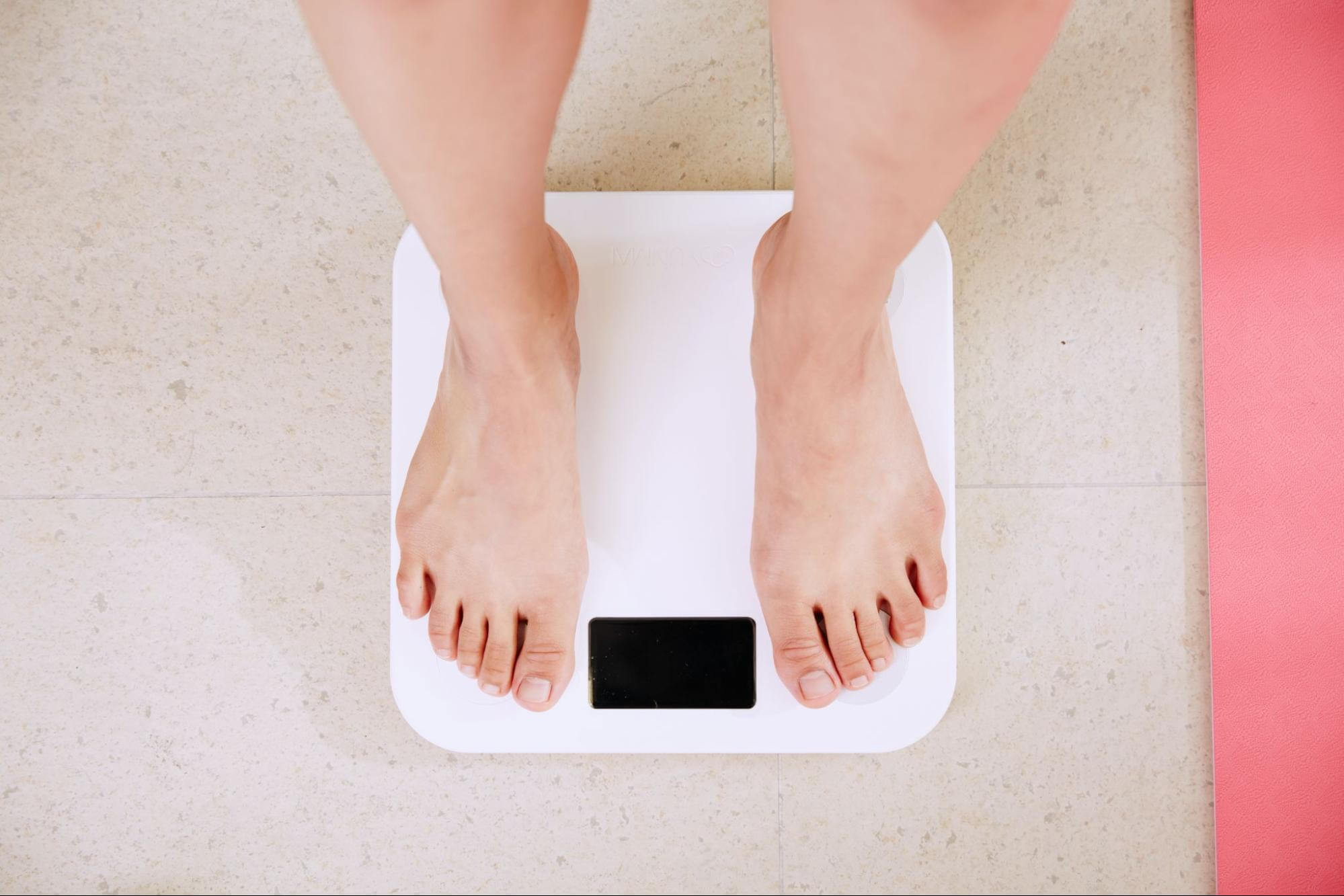Losing 40 pounds might seem like an impossible feat, especially with so many quick-fix diets and false expectations. However, gaining and maintaining a healthy weight is very attainable, and it does not have to include deprivation or unsustainable activities.
How To Lose 40 Pounds Sustainably
Set a Realistic Goal
When attempting to lose 40 pounds, it is critical to establish a realistic weekly weight loss target. Aim to lose 1-2 pounds each week for consistent and long-term weight loss.
Losing 1-2 pounds every week may not appear to be much, but it adds up to 4-8 pounds lost per month. At this rate, you may drop 40 pounds in 5-10 months, which is a reasonable time frame.
Rapid weight reduction of more than 2 pounds per week is not advised since it often entails excessive calorie restriction and water weight loss rather than long-term fat loss. Focus on shedding fat in a healthy way rather than merely reducing weight on the scale.
Set a deadline for when you want to attain your ideal weight. This might be associated with a specific occasion, such as a trip, wedding, or birthday. Set a fair time frame of 6 months to a year. A deadline can help you stay motivated to stick to your weight reduction goal.
Remember that even dropping 1-2 pounds each week will result in considerable progress over time. As you work toward your greater 40-pound objective, set mini-goals like dropping 5 pounds in a month. You can lose 40 pounds in a healthy, lasting method if you are consistent and committed.
Be in a Calorie Deficit
You must consume fewer calories than you burn each day to lose weight. A popular first objective is to produce a 500-1000 calorie deficit each day, which results in 1-2 pounds of weight reduction per week.
The first step is to compute your daily total energy expenditure (TDEE). This is the number of calories your body burns every day as a result of fundamental functions, daily activities, and exercise.
To gain a ballpark estimate of your maintenance calories, use an online TDEE calculator. Make sure to input your statistics correctly.
Subtract 500-1000 calories from your TDEE to estimate your desired calorie intake for weight reduction. If your TDEE is 2500 calories, consuming 1500-2000 calories per day would provide an appropriate deficit.
You’ll need to reassess your TDEE and alter your calorie intake as you lose weight. As you lose weight, your TDEE falls.
Tracking your daily calorie consumption and weight fluctuations can help you evaluate whether you need to reduce your intake even more to continue losing weight. Aim for a consistent, sustained weight loss of 1-2 pounds each week.
Focus on Nutrient Dense Foods

Eating meals that are high in nutrients about their calorie level will help you feel fuller while losing weight. Make sure to obtain lots of the following:
Protein–rich foods such as lean meats, eggs, seafood, beans, nuts, and seeds keep you satiated for longer while also promoting muscle building. Aim for 0.5 to 1 gram of protein per pound of body weight every day.
Fruits are packed with fiber, vitamins, minerals, and antioxidants. They’re fantastic for snacks or desserts. To receive the extra benefit of fiber, choose whole fruits over liquids.
Vegetables – Consume a variety of non-starchy vegetables such as leafy greens, broccoli, bell peppers, and mushrooms. They supply essential nutrients while consuming a few calories.
Whole grains – For critical minerals and fiber, choose 100% whole grain alternatives such as brown rice, quinoa, oats, and whole wheat bread.
Healthy fats – Avocados, salmon, almonds, and olive oil satiate appetite while also improving heart health. Put them ahead of saturated and trans fats.
Simultaneously, reduce empty calories from added sugars, processed carbohydrates, and bad fats that deliver little nutrition:
Limit your intake of sweets, sodas, juices, white bread, pastries, and fried meals.
Choose lean proteins and low-fat dairy over heavy meats and full-fat cheese.
Use vegetable oils instead of butter, shortening, or lard for cooking.
Making modest substitutions to emphasize healthful, nutrient-dense foods, as outlined, will help you lose weight without feeling deprived.
Manage Portions
When it comes to reducing weight, it’s critical to watch your portion sizes. Consistently eating large quantities might result in an overabundance of calories, making weight reduction difficult. Here are some suggestions for portion control:
Make use of smaller plates. Eating from large dinner plates might unintentionally lead to larger servings. Use smaller salad plates to make your quantities look larger.
Portion control. To portion out meals, use measuring cups and spoons. Check the serving size on the box for further information. Portion sizes for meat, cereals, snacks, and other foods should be considered.
Stop eating when you’re full, not stuffed. Pay attention to your body’s fullness signs. Stop eating when you are satisfied but not stuffed. Avoid going back for more.
Portion control requires awareness, but it may have a significant influence on calorie consumption and weight reduction. Portion control is important for avoiding overeating.
Stay Hydrated

Water is crucial for general health and weight reduction success. When you are hydrated, your body can break down stored fat and get energy more effectively. Dehydration causes weariness and lowers metabolism.
Aim to consume 64 ounces (8 cups) of water every day. More if you’re active and sweating profusely.
Water is the healthiest option, but unsweetened coffee and tea can count toward your recommended fluid requirement. Avoid consuming calories in the form of juice, soda, sweet tea, sports drinks, specialty coffee drinks, beer, wine, mixed drinks, and other alcoholic beverages.
The calories in these liquid sources are not filling and will stymie your weight loss efforts.
If you don’t like plain water, flavor it with lemon, lime, cucumber, mint, grated ginger, or other natural flavors. Simply avoid adding sugar. Investing in a good water bottle or glass can also help to make your hydration routine more pleasurable.
To assist in filling your stomach, drink a glass of water before meals and snacks. Staying hydrated will assist you in making healthy eating choices and portion control. Aim for no or extremely diluted urine—this indicates adequate hydration.
Exercise and Move More
To effectively lose 40 pounds, you must increase your physical activity. Aim for 150-300 minutes per week of moderate exercise. This might be a combination of aerobic and strength training.
Some suggestions for increasing physical activity include:
- Walk for 30-60 minutes 3-5 times a week.
- Participate in a dancing or aerobics class several times per week.
- Lift weights at least twice a week3 times per week, swim laps
- Simple strategies to boost your everyday activity include
- Instead of using the elevator, take the steps.
- Place your car further away from the entrances.
- Take small walks throughout your lunch and break times.
- Perform home duties such as vacuuming, car washing, and gardening.
Starting an exercise routine can be challenging, but try to find activities you enjoy. It may help to exercise with a friend or join a class to stay motivated. Moving more is key for long-term weight loss success.
Get Plenty of Sleep

Getting enough quality sleep is critical for weight reduction success. Aim for 7-9 hours of sleep every night, which is the amount advised for adults. Maintaining a consistent sleep pattern aids in the regulation of your circadian rhythm, allowing your body to produce hormones that control appetite at the appropriate periods.
Limit screen usage for at least 1-2 hours before going to bed. Blue light generated by phones, tablets, and laptops inhibits melatonin synthesis, making it more difficult to fall and stay asleep. Establish a calming pre-bedtime ritual, such as taking a bath, reading, or meditating, to help you unwind. To promote comfortable sleep, keep your bedroom cold, dark, and quiet.
A sufficient amount of sleep allows your body to rebuild muscles, allowing you to recover from activity and burn calories more efficiently. Sleep deprivation alters appetite-regulating hormones such as leptin and ghrelin, resulting in increased hunger and desires for sweet, fatty meals.
Getting adequate quality sleep will assist you in sticking to your weight loss objectives.
Manage Stress
In many ways, stress leads to weight gain. It can interfere with sleep, causing you to eat more, and raise cortisol levels, which contributes to fat storage.1 Managing your stress is critical while attempting to lose weight.
Make time every day to rest and unwind. Reading, having a bath, or spending time outside can all help reduce stress. Yoga, meditation, or deep breathing techniques are all options. These mind-body techniques help to relax the nervous system and reduce the consequences of stress.
It is also critical to have a strong support system. Talk to your friends, join a support group, or consult with a therapist. Social support mitigates the effects of stress. Don’t try to lose weight on your own. Having somebody to turn to simplifies the process significantly.2
Be Accountable
Accountability is essential for keeping motivated and on track to achieve your objective. Here are some pointers:
Track Foods and Activity
Track what you eat and drink each day with an app or a diary. This keeps you conscious of your habits.
Keep track of your regular activities as well. Tracking, whether for exercise or steps, makes you aware of your movements.
Check your tracking on a daily or weekly basis to verify you’re still in a calorie deficit.
Share Goals with Friends/Family
Inform close friends and family about your weight loss plans. Their encouragement might help motivate you.
Share your tracking and progress regularly. If you fall off track, accountability partners can assist.
Request that they follow up on your progress and join you in healthful activities. A good support system is priceless.
Celebrate Small Wins
Give yourself a non-food incentive for every 5 pounds dropped.
Every week, you stick to the schedule and celebrate your commitment.
Focusing on little goals helps the big objective seem more attainable.
Stick to It
Making long-term lifestyle adjustments is not always simple. When attempting to lose 40 pounds, you will most likely experience plateaus when the scale does not budge for weeks or setbacks where you regain a couple of pounds. It is critical not to become disheartened. Keep an eye on the larger picture and remember why you started this adventure in the first place.
Conclusion
Remember that reducing 40 pounds will most likely need months of constant healthy food and activity. Don’t become impatient and try extreme diets to hasten things along. Drastic diets are unsustainable, and you will most likely regain the weight. Make little, manageable modifications that you can stick to in the long run.
Joining an accountability group, sharing your objectives with loved ones, or using monitoring software can all assist. Having a support system and being accountable to others reduces the likelihood that you will stray from your goals when you reach a plateau or have a bad day.
When you’re about to give up, consider what inspires you. Examine past images of yourself or create vision boards for your weight loss objectives. Remember all the advantages of accomplishing your goal, such as having more energy, increasing your confidence, and improving your health. Maintain your focus – with commitment and determination, you may lose 40 pounds safely and permanently.
If you enjoyed this article, you may also want to read this article on 10 Effective Strategies to Lose 50 Pounds in a Month.
*This information is not intended to serve as a substitute for professional medical or dietary advice tailored to individual needs.
Po-Chang Hsu, M.D., received his medical doctorate from Tufts University School of Medicine in Boston. During his medical school training, Dr. Hsu worked with various patients, including adult and pediatric patients with acute and chronic conditions. Dr. Hsu’s interests include neurology, psychiatry, pediatrics, and sleep medicine.
Before medical school, Dr. Hsu finished a master’s degree at Harvard University and wrote a thesis on neuroimaging in schizophrenia patients at Brigham and Women’s Hospital, a Harvard Medical School-affiliated hospital. Dr. Hsu was also a part of the 2008 NASA Phoenix Lander Mission team, which sent a robotic spacecraft to the North polar region of Mars. Dr. Hsu also had research experience on neuroimaging in neonates at Boston Children’s Hospital, another Harvard Medical School-affiliated Hospital.
Since graduating from medical school, Dr. Hsu has worked as a full-time medical writer and consultant. In addition, he has experience writing and ghostwriting books and articles for physicians and health technology start-up companies. Dr. Hsu believes good communication between healthcare providers and patients creates the best results.
Publications
-Peer Reviewed Journal Article:
Kounaves, S.P., Hecht, M.H., West, S.J., Morookian, J.-M., Young, S.M.M., Quinn, R., Grunthaner, P., Wen, X., Weilert, M., Cable, C.A., Fisher, A., Gospodinova, K., Kapit, J., Stroble, S., Hsu, P.-C., Clark, B.C., Ming, D.W. and Smith, P.H. The MECA wet chemistry laboratory on the 2007 phoenix mars scout Lander. Journal of Geophysical Research. 2009, Mar; 114(E3): 10.1029/2008je003084.
-Poster Presentation:
2011 Harvard Psychiatry Mysell Poster Session; Boston, MA
Hsu, P.C., Rathi, Y., Eckbo, R., Nestor, P., Niznikiewicz, M., Thompson, E., Kubicki, M., Shenton, M.E. (March, 2011). Two-Tensor Diffusion Tensor Imaging of Acoustic Radiations in Schizophrenia




